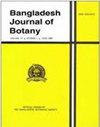Allelopathy and weed control ability of three cover crops residues, in conservation of agriculture
IF 0.3
4区 生物学
Q4 PLANT SCIENCES
引用次数: 0
Abstract
The weed suppressive potential of three cover crops: two forage hybrids of corn and sorghum and a local population of millet, used in conservation of agriculture was investigated. The allelopathic potential of cover crops was studied based on bio-assays. The effect of three tested crops were used on weed dynamics (weed density, Weed Control Efficiency (WCE). Two types of residues management (TRM) were followed: standing and incorporated residues (SR, IR).Forage residues showed an allelopathic effect on germination and seedlings growth of rye-grass. Sorghum significantly reduced weed density. Incorporated residues method was more effective than standing residues in reducing weed density. Millet residues was more efficient to control weeds whereas corn residues increased weed biomass. Weed Control Efficiency was also influenced by two types of residues management which showed a highly significant interaction with tested crops. Bangladesh J. Bot. 52(3): 845-852, 2023 (September)三种覆盖作物残留物在保护农业中的异化作用和除草能力
研究了三种覆盖作物对杂草的抑制潜力:两种玉米和高粱的饲料杂交种以及一种用于保护农业的当地粟。通过生物测定研究了覆盖作物的等位潜力。使用了三种测试作物对杂草动态(杂草密度、杂草控制效率(WCE))的影响。牧草残留物对黑麦草的发芽和幼苗生长有等位病理效应。高粱明显降低了杂草密度。在降低杂草密度方面,掺入残留物法比静置残留物法更有效。小米残留物控制杂草的效率更高,而玉米残留物则增加了杂草的生物量。杂草控制效率还受到两种残留物管理方式的影响,这两种方式与测试作物之间存在非常显著的交互作用。孟加拉国植物学杂志52(3):845-852,2023 年(9 月)
本文章由计算机程序翻译,如有差异,请以英文原文为准。
求助全文
约1分钟内获得全文
求助全文
来源期刊

Bangladesh Journal of Botany
生物-植物科学
CiteScore
0.80
自引率
0.00%
发文量
77
审稿时长
9 months
期刊介绍:
Bangladesh in situated on the north of Bay of Bengal. Climatically it is a humid subtropical country. Most of the land is deltaic plain of two great rivers, the Ganges and the Bhrammaputra and it tributaries. The country has rich diversity of plants. Main crops cultivated are Rice, Jute, Wheat, Maize, Sugarcane, Mustard and different kinds of Lentils. There are a good number of Public and Private Universities and Plant Research Establishments.
Bangladesh Journal of Botany is the official organ of the Bangladesh Botanical Society established in 1972. Since 1972 Bangladesh Journal of Botany is being published regularly. Two issues of the Journal are published, one in June and another in December.
Scientific papers (Full paper and short communication) on any field of Plant Sciences from anywhere in the World are considered for publication in Bangladesh Journal of Botany.
 求助内容:
求助内容: 应助结果提醒方式:
应助结果提醒方式:


